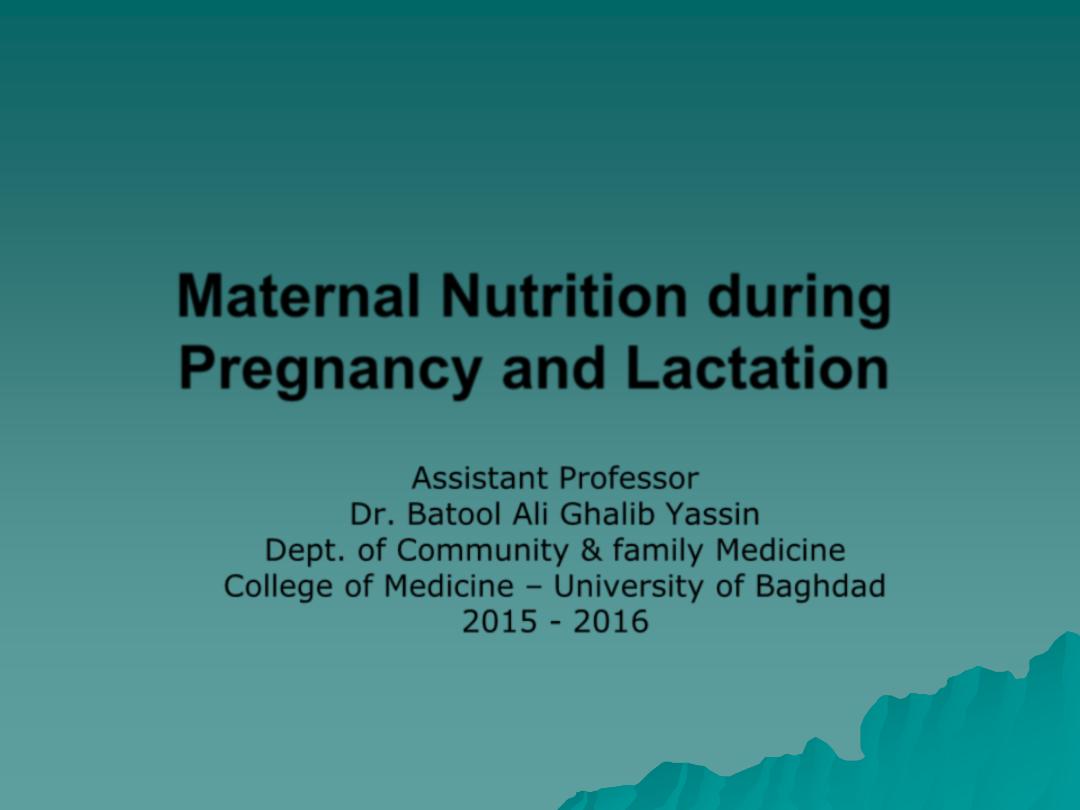
Maternal Nutrition during
Pregnancy and Lactation
Assistant Professor
Dr. Batool Ali Ghalib Yassin
Dept. of Community & family Medicine
College of Medicine – University of Baghdad
2015 - 2016
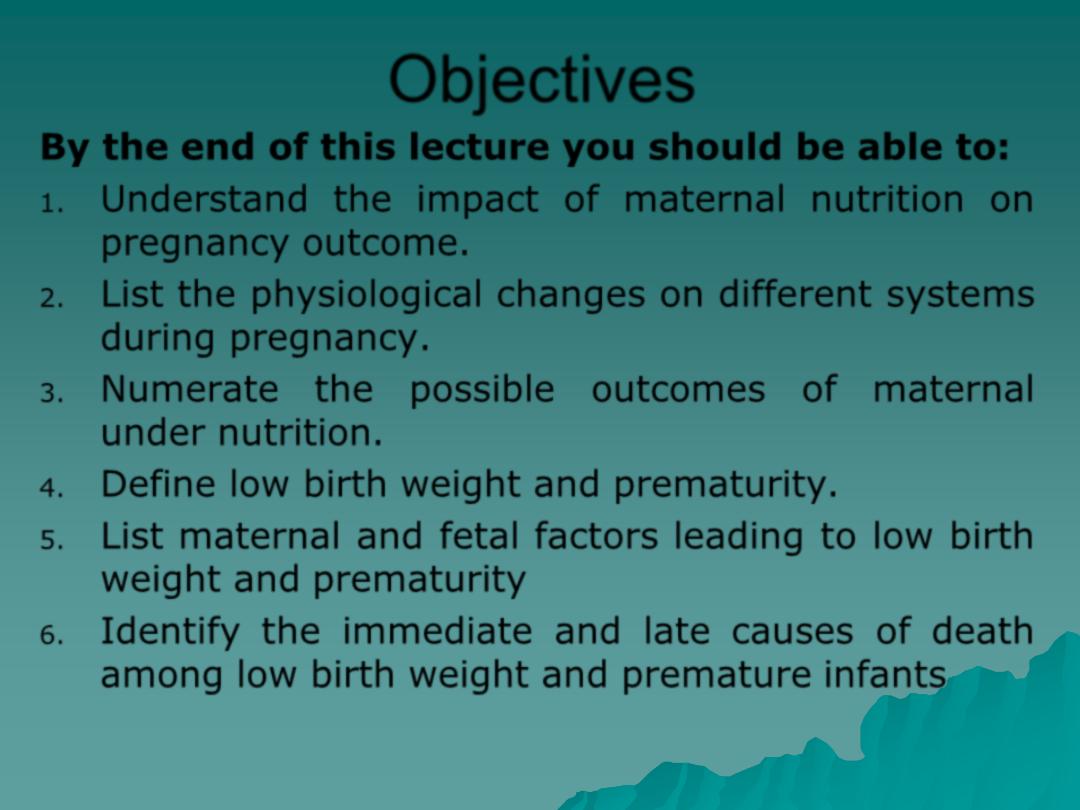
Objectives
By the end of this lecture you should be able to:
1.
Understand the impact of maternal nutrition on
pregnancy outcome.
2.
List the physiological changes on different systems
during pregnancy.
3.
Numerate the possible outcomes of maternal
under nutrition.
4.
Define low birth weight and prematurity.
5.
List maternal and fetal factors leading to low birth
weight and prematurity
6.
Identify the immediate and late causes of death
among low birth weight and premature infants
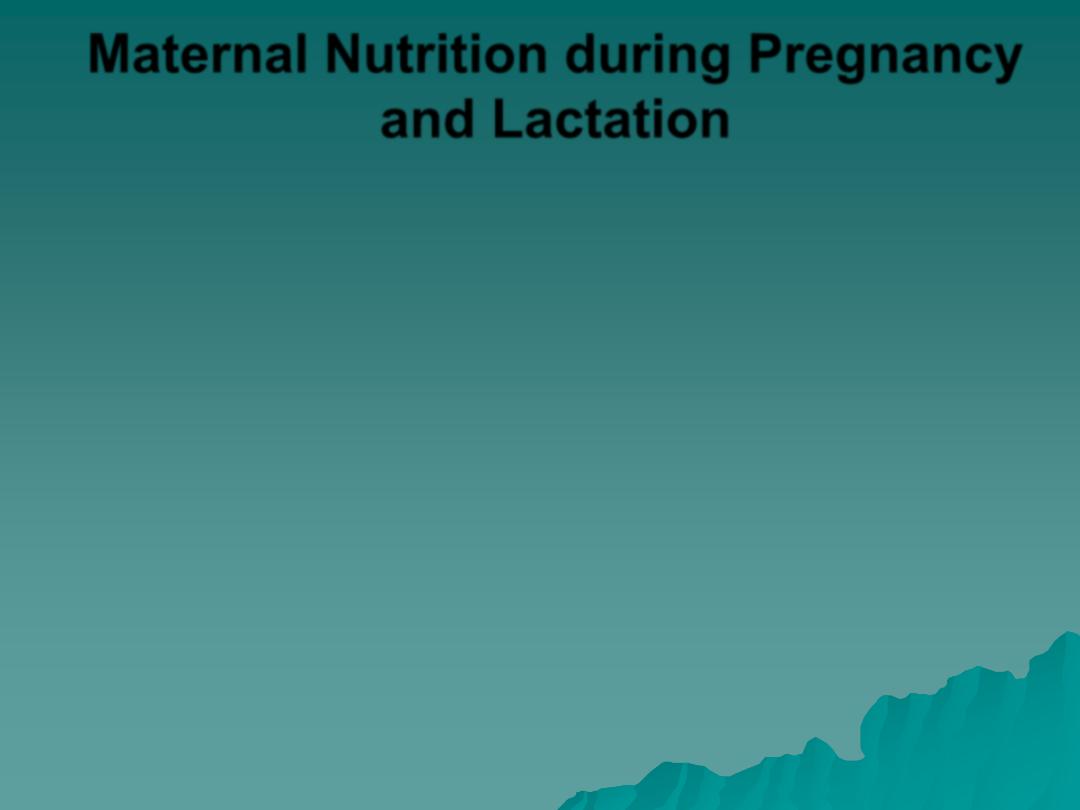
Maternal Nutrition during Pregnancy
and Lactation
Nutritional Status of the mother is
important for its impact on:
1.
Mother’s health.
2.
Fetal wellbeing
3.
Lactation
4.
Certain deficiencies cause dangerous
situations eg. Iodine deficiency

Physiological changes during pregnancy
General
metabolism
Anabolic
state
↑ BMR
Blood
volume
↑ plasma
volume
by 50%
and red
cell mass
by 20%
↓Hb concentration
in the peripheral
blood by 2 g/dl
Physiological
anemia
Water
metabolism
amount
of water
in the
maternal
body is
increased
by about
7 liters
Renal
function
GIT
↑ GFR
loss of
sugar
and
amino
acids
in the
urine
nausea,
vomiting,
constipati
on and
impaired
absorption
eg. iron
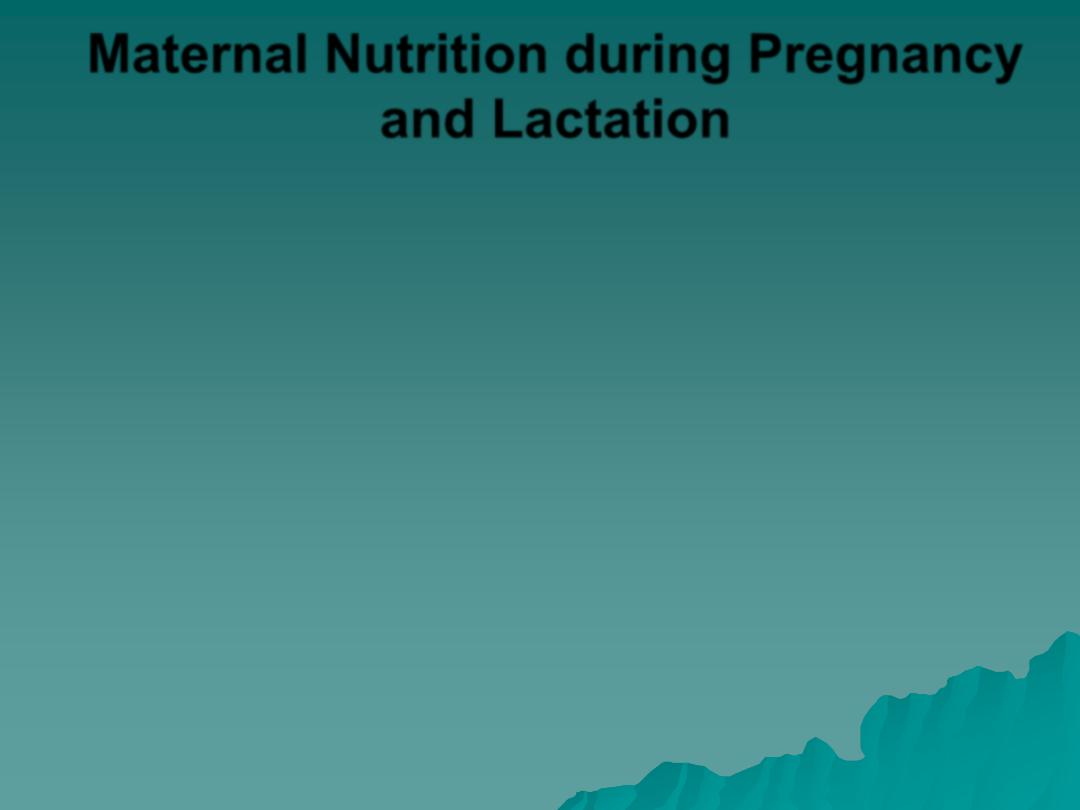
Maternal Nutrition during Pregnancy
and Lactation
Under
normal
conditions
the
mother’s weight increase by about 20 %
during pregnancy. In well nourished
mothers this correspond to an average
weight gain of 12.5 Kg (10-12 Kg)
throughout the pregnancy.

Possible Outcomes of Maternal
Under-nutrition:
1. Pre-eclampsia and Eclampsia:
A condition characterized by hypertension,
edema and protein urea
More common in lower socio-economic
groups and in developing countries.
They may be related to certain nutritional
deficiencies.

Possible Outcomes of Maternal Under-nutrition:
2. Anemia
Defined as a hemoglobin concentration of less than
11gm/dl
Physiological changes during pregnancy
→ relative
anaemia of pregnancy and is not always accompanied by
hypochromia (as indicated by normal MCHC values).
However, this is the picture in the peripheral blood.
In developing countries the iron stores are usually
depleted due to successive periods and pregnancy and
lactation and diets containing low iron, mostly of low bio-
availability.
Low MCHC means low Hb content of RBC & hypocromic and
microcytic RBCs will appear on blood film.
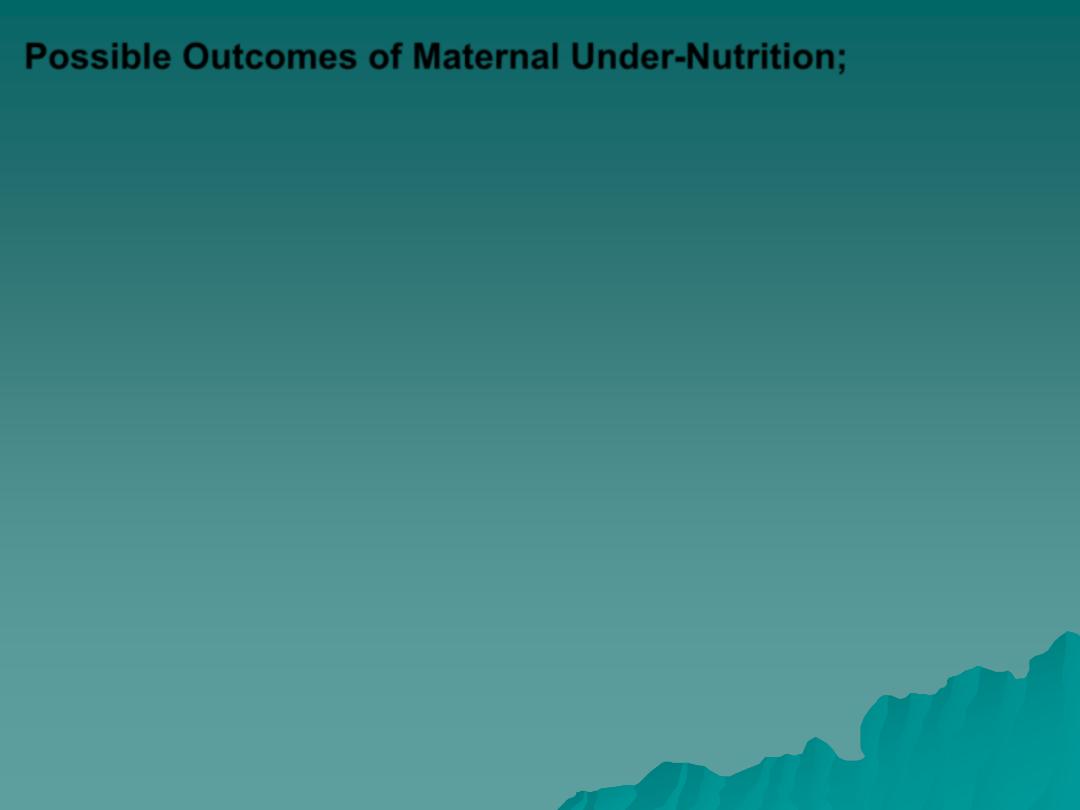
Possible Outcomes of Maternal Under-Nutrition; 2. Anaemia:
Degree of anaemia
-
Moderate (Hb 7 -10 gm/dl) - PCV (24 – 37 %)
-
Severe (Hb 4 -6.9 gm/dl) - PCV (13 – 23 %)
-
Very severe (Hb less than 4 gm/dl) - PCV (< 13 %)
The causes of anaemia during pregnancy are:
1.
Increased iron requirements due to foetal & placental growth.
2.
Impairment of iron metabolism during pregnancy.
3.
Short spacing.
4.
Dietary iron deficiency (low iron content and low bio-
availability).
5.
Blood loss due to parasites (anchylostoma and plasmodia).
6.
Anaemia may also be due to the deficiency of folic acid and/or
vitamin B
12
. This is manifested by very low HB values of <7g/dl.
In Iraq, low Hb levels not responding to iron supplements may
indicate thalassaemia or sickle cell anaemia.
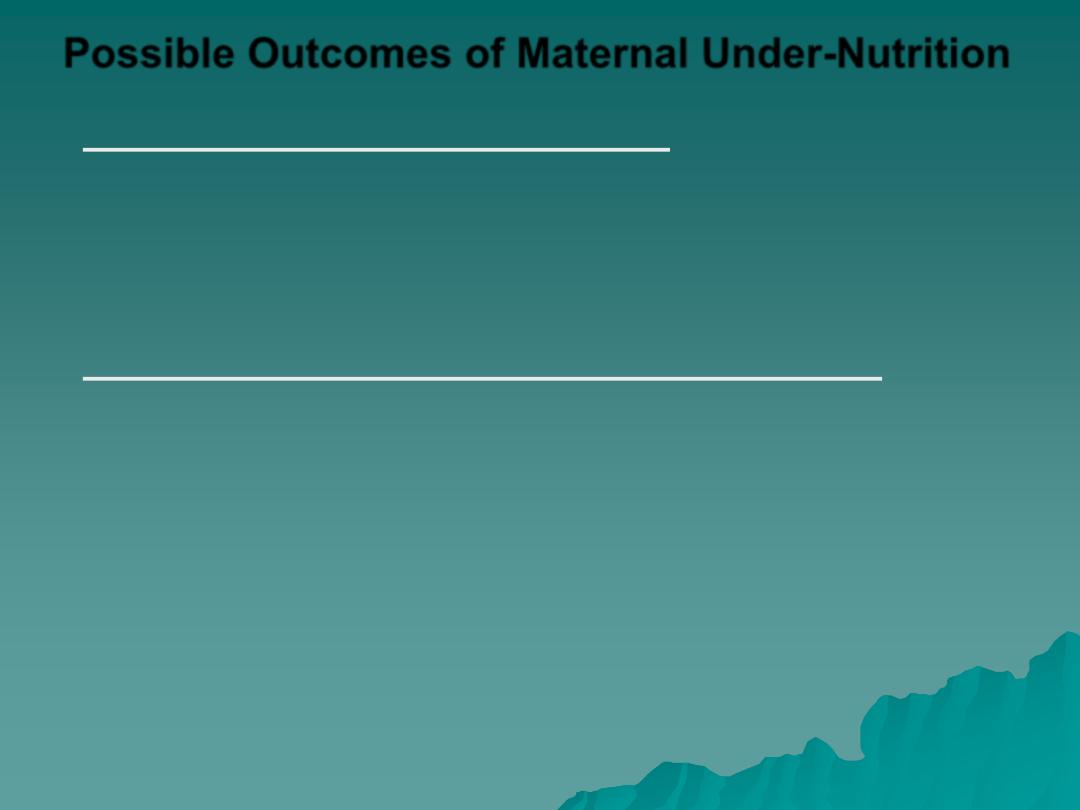
Possible Outcomes of Maternal Under-Nutrition
3. Low Birth weight & Prematurity:
Both of these outcomes show a socio-economic gradient.
They are more common among lower social classes and
in developing countries.
4. Foetal and Neonatal Morbidity and Mortality:
There is also a socio-economic gradient in fetal and
neonatal morbidity and mortality.
The under-nourished fetus and neonate usually show a
general depression of vitality and have an increased
chance of death during the neonatal period.
Congenital malformations have been produced in
pregnant animals maintained on deficient diets.
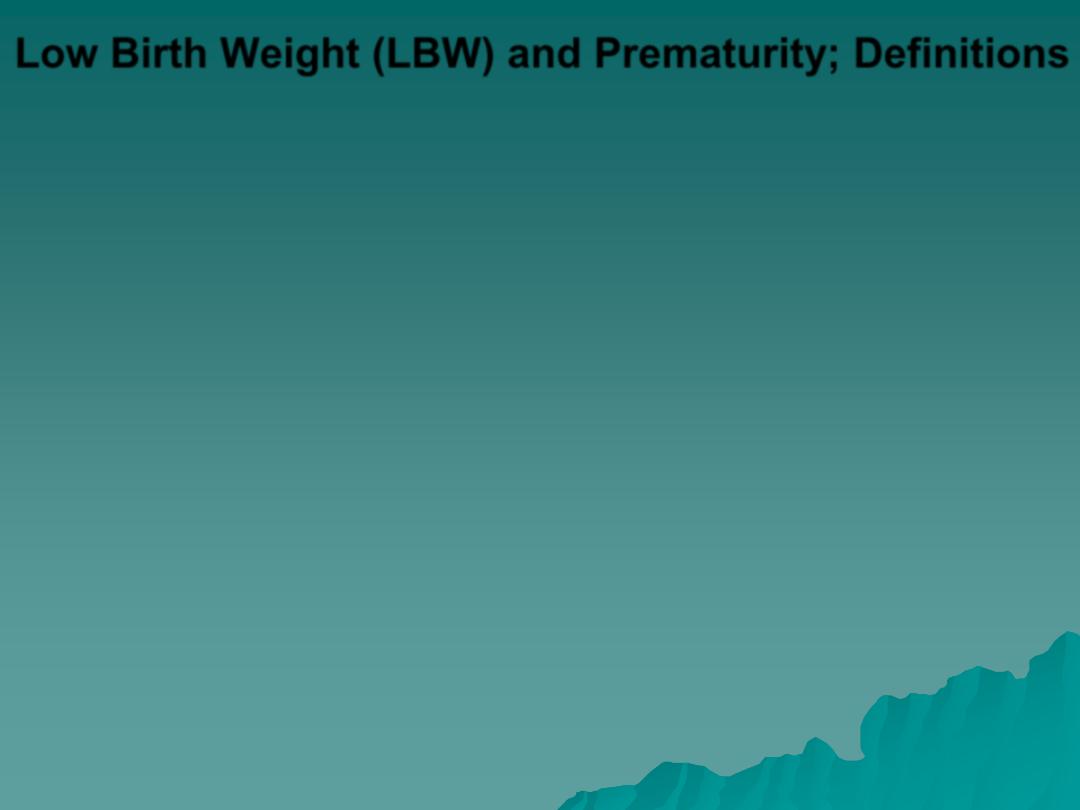
Low Birth Weight (LBW) and Prematurity; Definitions
The birth weight of an infant is very important because it
determines his ability to adapt to the new environment and
develop normally.
Many factors causes variation in weight at birth but in
developing countries, the mother’s health , nutritional
status and diet during pregnancy are probably most
important.
Normal birth weight for infants of either sex (3.3-3.5Kg)
Environmental and hereditary factors affect the infant’s
birth weight.
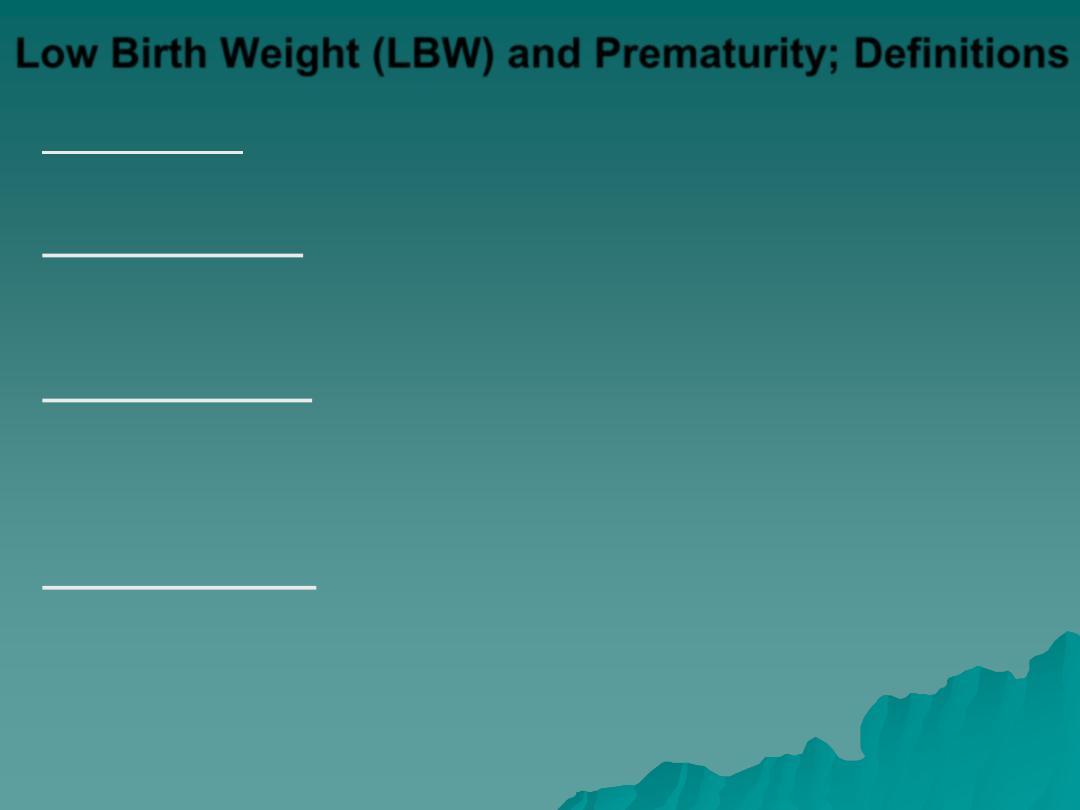
Low Birth Weight (LBW) and Prematurity; Definitions
LBW infant:
A live born infant weighing less than 2500g at birth.
Pre-term infant:
An infant born before 37 completed weeks of gestation
calculated from the first day of the last menstrual period.
Full-term infant:
An infant born between 37-42 completed weeks of
gestation calculated from the first day of the last menstrual
period.
Post-term infant:
An infant born after 42 completed weeks of gestation
calculated from the first day of the last menstrual period.
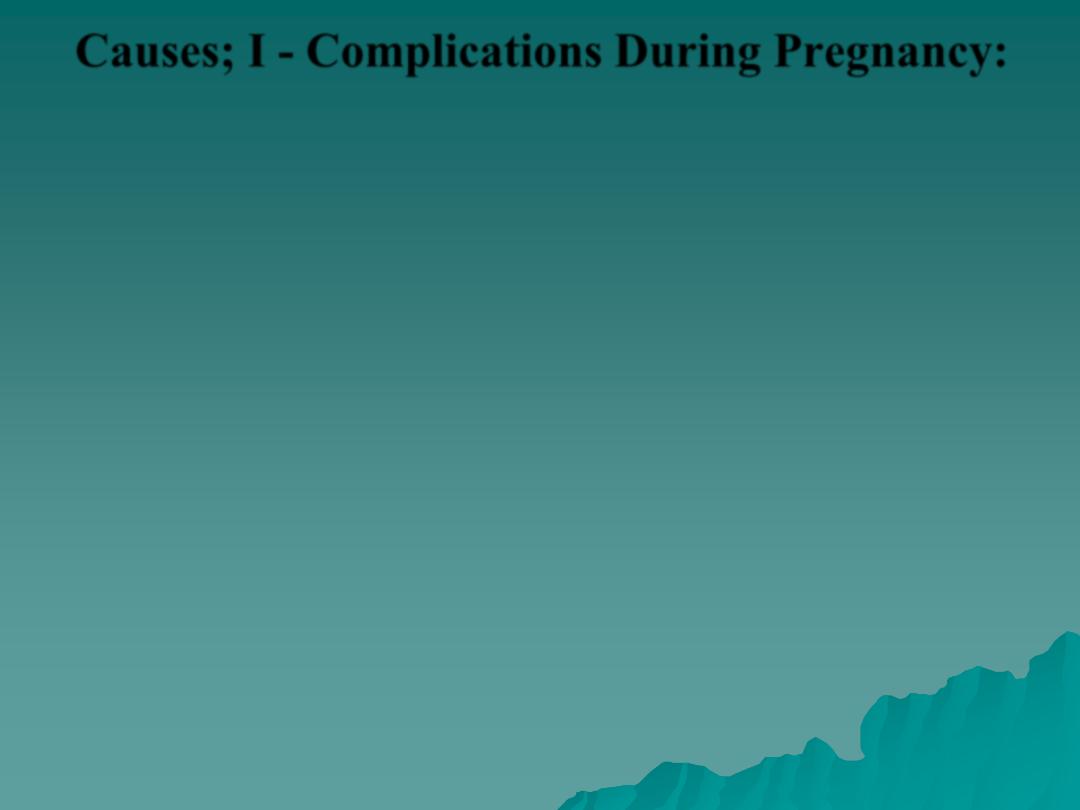
Causes; I - Complications During Pregnancy:
1. Hypertension:
It can happen with or without proteinuria (pre-eclampsia or
essential hypertension). It can be associated with or lead to
placental abnormalities. These conditions may lead to both
IUGR & pre-term delivery.
2. Diabetes Mellitus:
Sometimes pregnancy is terminated before 37 completed weeks
of gestation, to protect the vitality of the infant. This will lead to
the birth of a pre-term infant. Sometimes, DM is associated with
placental insufficiency which in severe cases is associated with
the birth of a small-for –date infant, although DM is usually
associated with the birth of a large-for-date infant.
3. Heart Diseases:
associated with pre-term delivery, which is sometimes induced.
4. Anaemia:
associated with LBW and pre-term delivery.
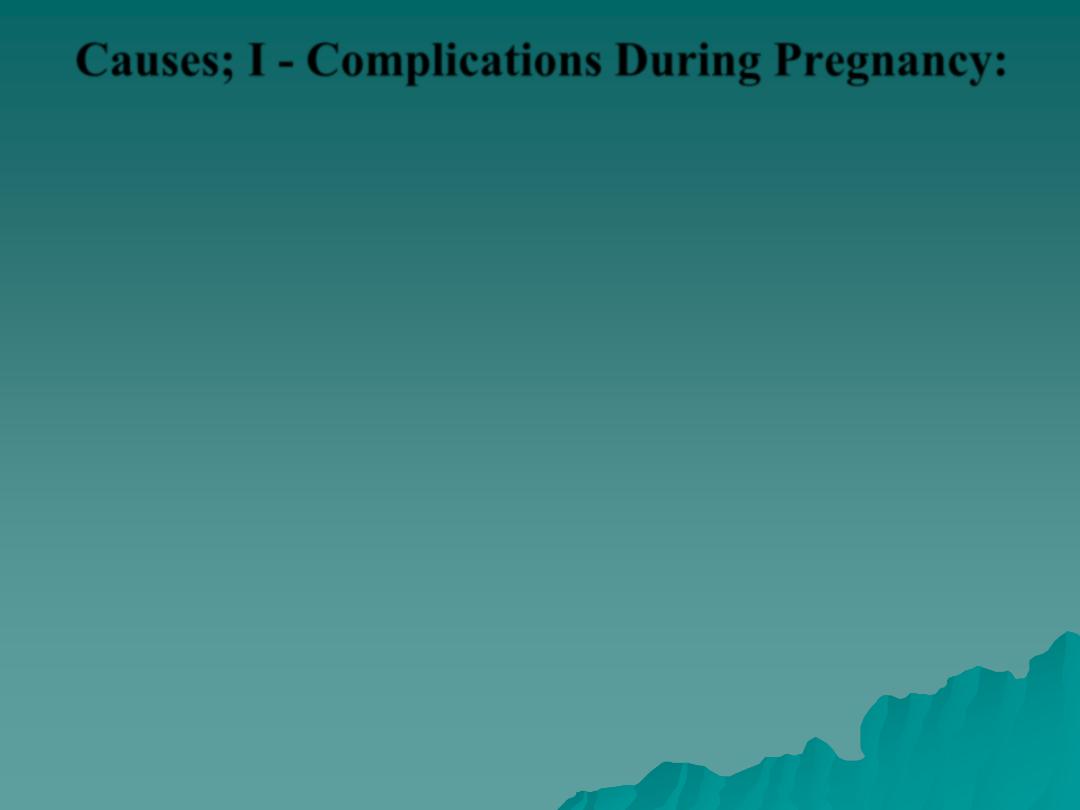
5. Infections:
Infections during pregnancy are associated with fever, immunological
reactions, obliterative vasculitis, release of toxic substances. The damage caused
is related
to the infectious agent
, the
timing of the infection
and
the organs or
tissues involved
. These infections may be:
A. Viral
:
Rubella, Cytomegalovirus, and Herpes
.
B.
Bacterial
: can either be
Amniotic
fluid infections (ascending antenatal bacterial infections, which are the
most common, are associated with protein energy malnutrition and heavy
physical work and lead to preterm delivery).
Trans-placental infections
(TB or syphilis which cause placental insufficiency
and preterm delivery).
Urinary tract infections
(UTIs which are associated with preterm delivery).
C. Parasitic:
Plasmodia
(congenital malaria is very rare as the fetus is protected by trans-
placental transmitted anti malarial antibodies, and the LBW and preterm delivery
are caused by the associated fever and severe anemia) .
Toxoplasma
(which is associated with pre-term delivery and congenital
malformations rather than LBW).
Causes; I - Complications During Pregnancy:
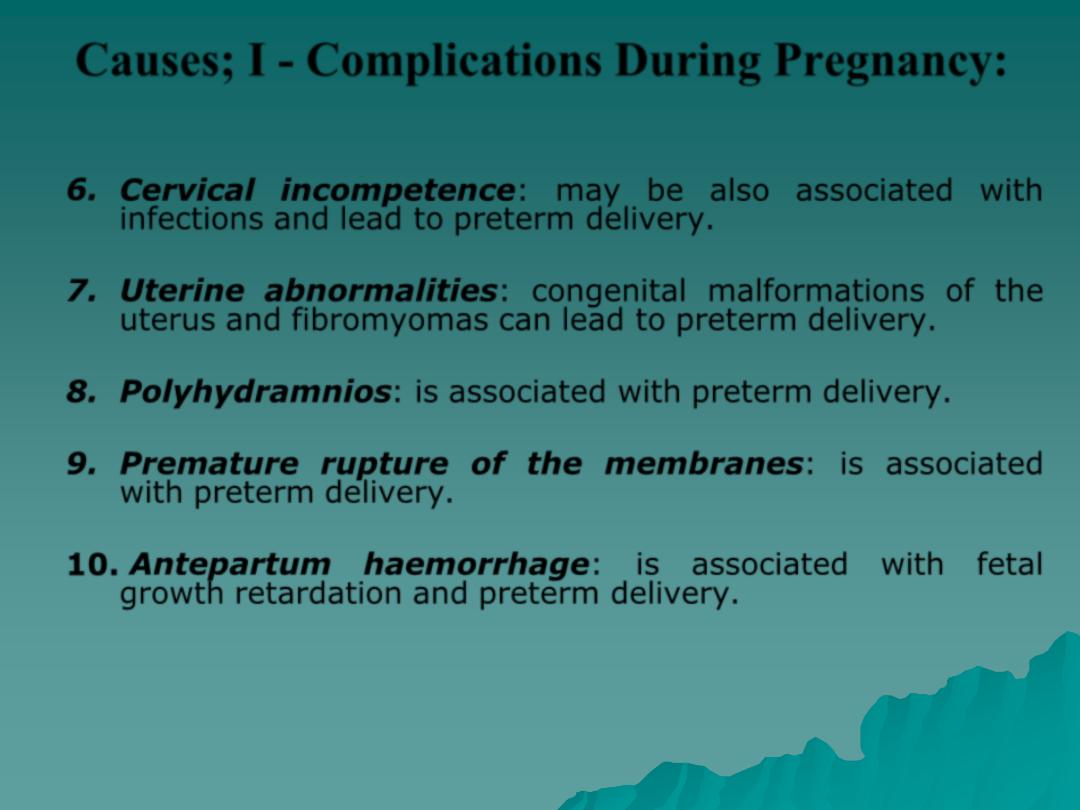
6. Cervical incompetence: may be also associated with
infections and lead to preterm delivery.
7. Uterine abnormalities: congenital malformations of the
uterus and fibromyomas can lead to preterm delivery.
8. Polyhydramnios: is associated with preterm delivery.
9. Premature rupture of the membranes: is associated
with preterm delivery.
10. Antepartum haemorrhage: is associated with fetal
growth retardation and preterm delivery.
Causes; I - Complications During Pregnancy:
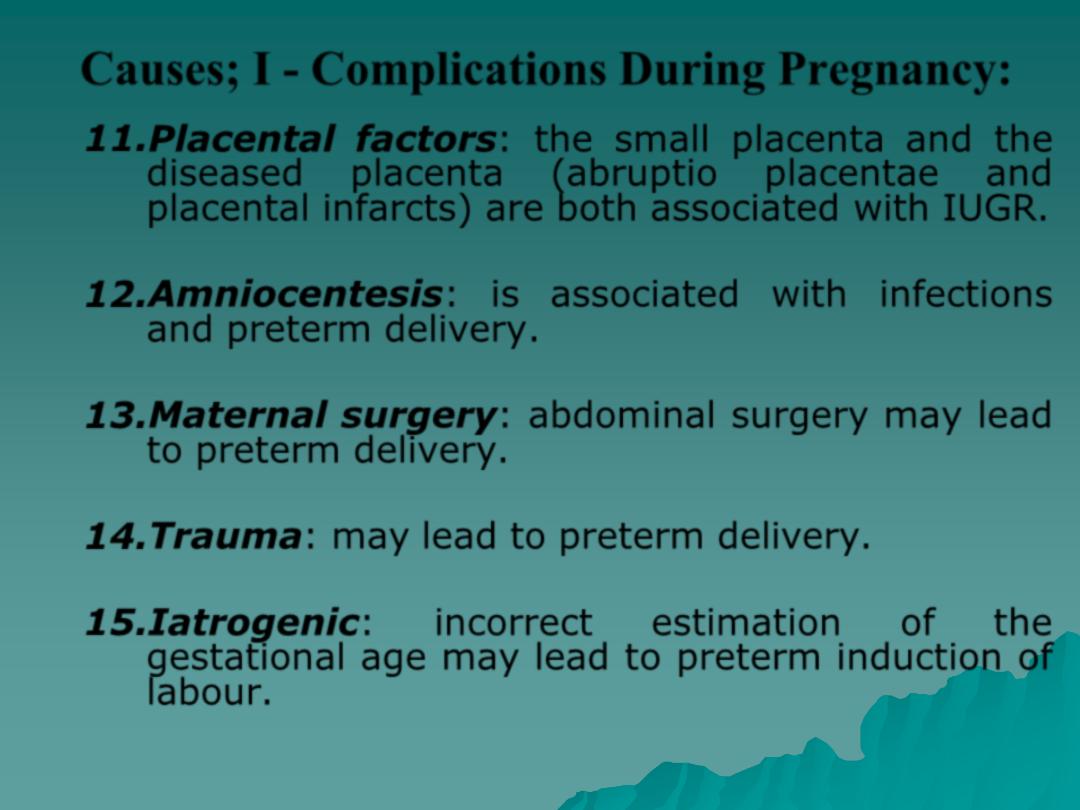
11.Placental factors: the small placenta and the
diseased placenta (abruptio placentae and
placental infarcts) are both associated with IUGR.
12.Amniocentesis: is associated with infections
and preterm delivery.
13.Maternal surgery: abdominal surgery may lead
to preterm delivery.
14.Trauma: may lead to preterm delivery.
15.Iatrogenic:
incorrect
estimation
of
the
gestational age may lead to preterm induction of
labour.
Causes; I - Complications During Pregnancy:
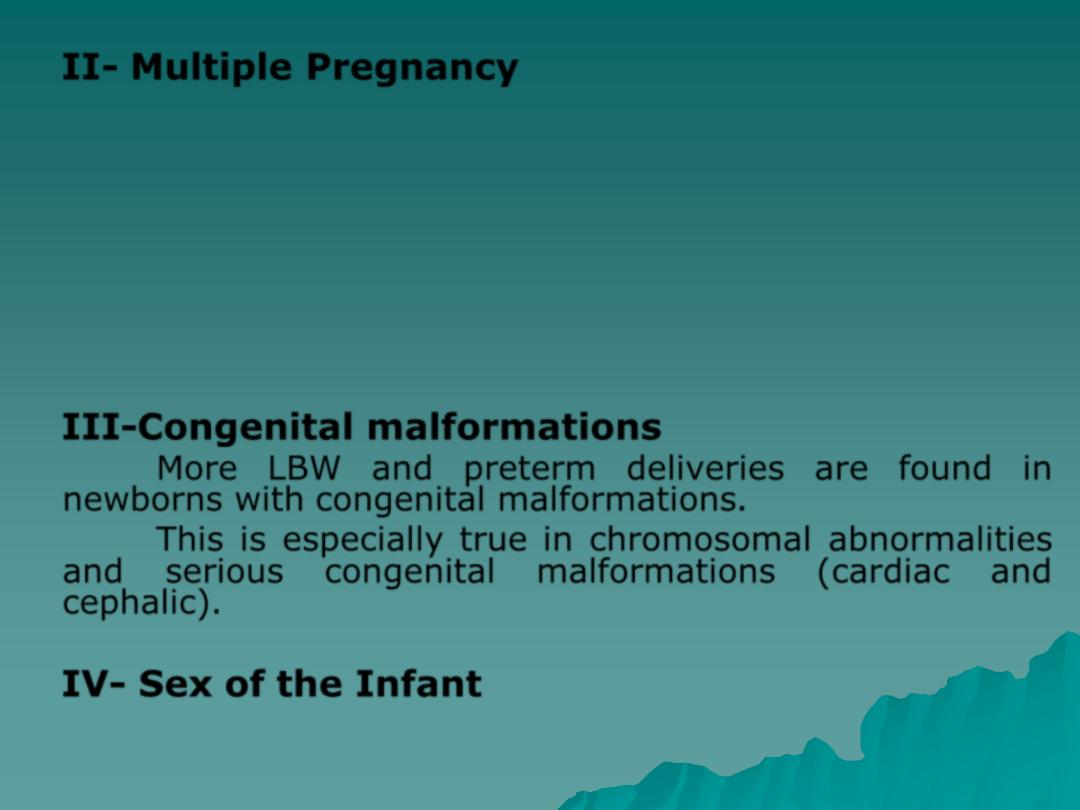
II- Multiple Pregnancy
–
In humans, intrauterine growth begins to falter between
26-30 weeks of gestation depending on the number of
fetuses.
– BW and GA decrease with increasing number of fetuses,
leading to a higher incidence of LBW and preterm delivery
in a multiple pregnancy. There is also a high incidence of
placental abnormalities in multiple pregnancies.
III-Congenital
malformations
More LBW and preterm deliveries are found in
newborns with congenital malformations.
This is especially true in chromosomal abnormalities
and serious congenital malformations (cardiac and
cephalic).
IV- Sex of the Infant
LBW
is higher in
female infants
, while
preterm
deliveries
are higher in the
male infant
.
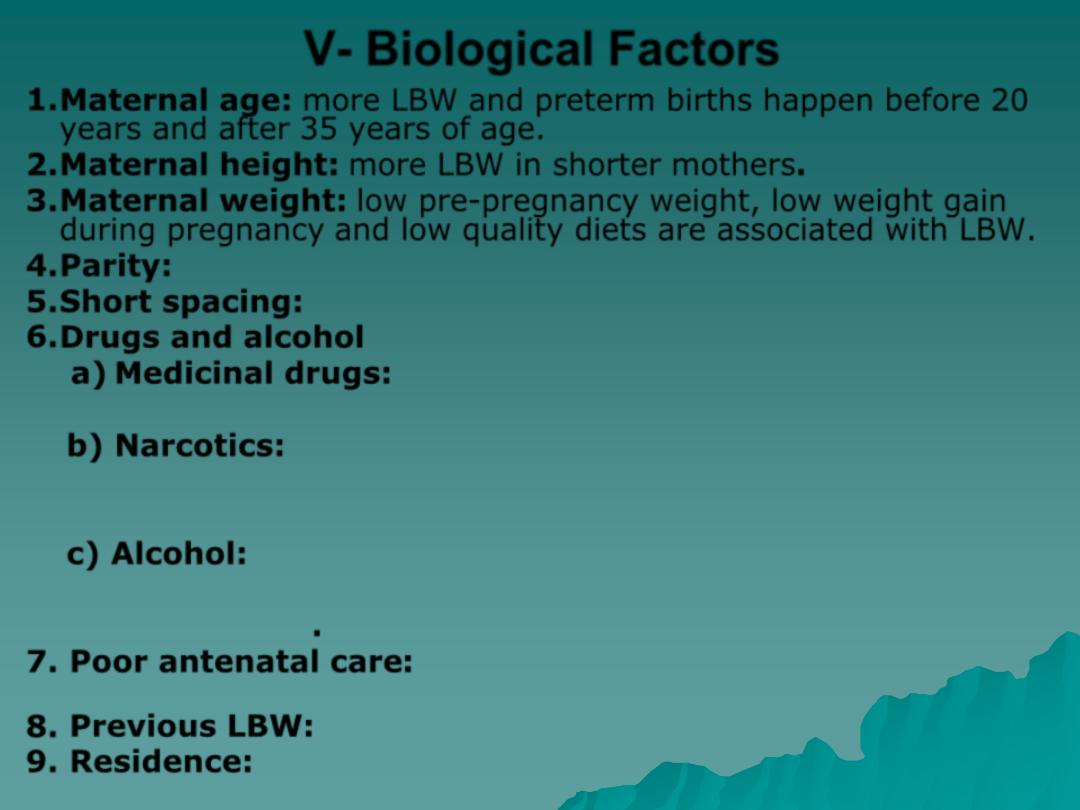
V- Biological Factors
1.Maternal age: more LBW and preterm births happen before 20
years and after 35 years of age.
2.Maternal height: more LBW in shorter mothers.
3.Maternal weight: low pre-pregnancy weight, low weight gain
during pregnancy and low quality diets are associated with LBW.
4.Parity: increased chance of LBW in first and after the 4th birth.
5.Short spacing: increased chance of LBW and preterm delivery.
6.Drugs and alcohol:
a) Medicinal drugs:
Some are teratogenic and may lead to IUGR
b) Narcotics:
Decrease food intake leading to maternal under-
nutrition and IUGR.
c) Alcohol:
Is teratogenic leading to LBW and fetal alcohol
syndrome.
7.
Poor antenatal care
: increased chance of LBW and preterm
delivery.
8.
Previous LBW
: increased chance of LBW and preterm delivery.
9.
Residence
: Increased LBW in rural areas and in higher altitudes.

V) Biological Factors
10.Occupation and physical activity
: hard
physical work are associated with a higher
chance of LBW and preterm deliveries especially
in developing countries.
11.Psychological stress
: is associated with
preterm labour.
12.Genetic factors
: about 40% of the variation in
birth weight is attributed to genetic factors
(ethnic and familial).
VI) Socioeconomic Factors:
Low social status,
Low family income,
low educational level and some husband’s
occupations
May lead to poor maternal nutrition which is
associated with LBW
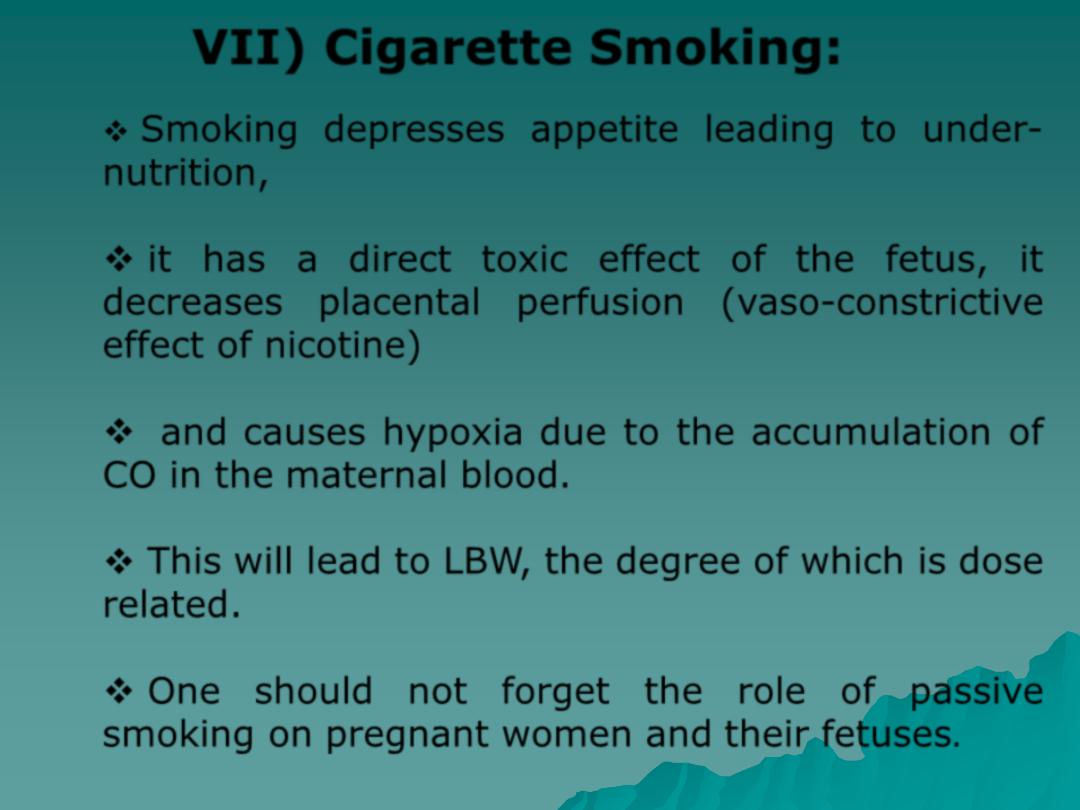
VII) Cigarette Smoking:
Smoking depresses appetite leading to under-
nutrition,
it has a direct toxic effect of the fetus, it
decreases placental perfusion (vaso-constrictive
effect of nicotine)
and causes hypoxia due to the accumulation of
CO in the maternal blood.
This will lead to LBW, the degree of which is dose
related.
One should not forget the role of passive
smoking on pregnant women and their fetuses
.
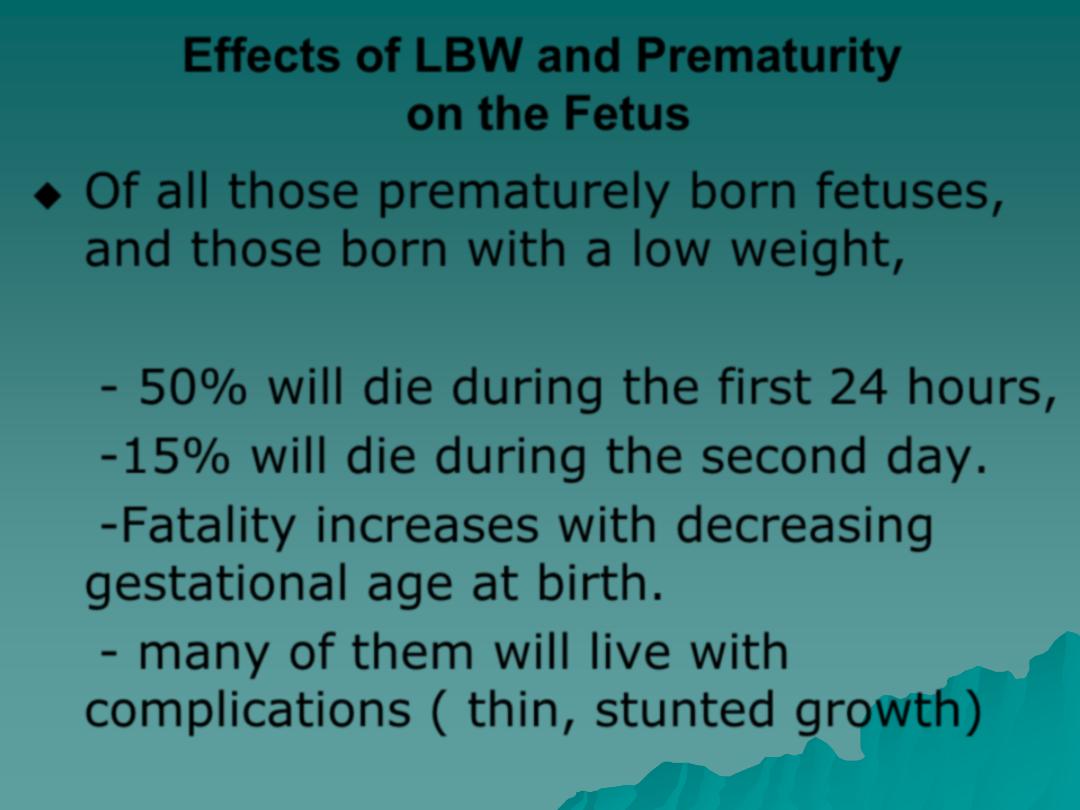
Effects of LBW and Prematurity
on the Fetus
Of all those prematurely born fetuses,
and those born with a low weight,
- 50% will die during the first 24 hours,
-15% will die during the second day.
-Fatality increases with decreasing
gestational age at birth.
- many of them will live with
complications ( thin, stunted growth)
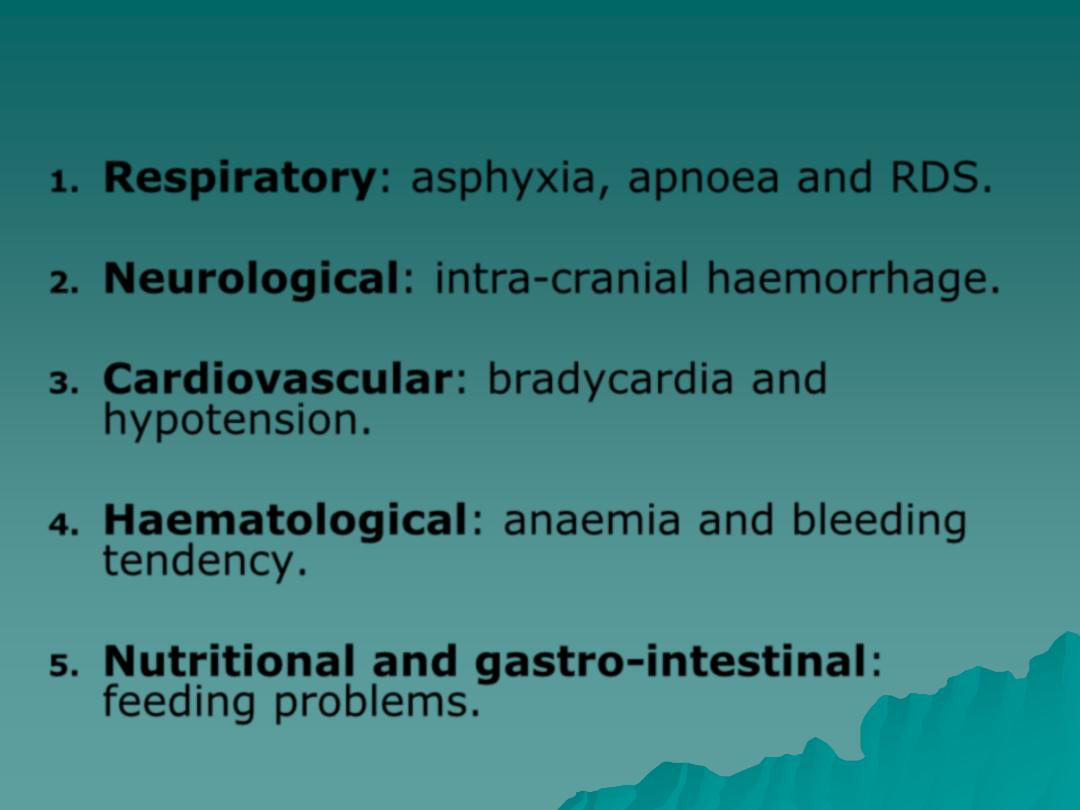
Causes of Morbidity and Mortality;
Immediate:
1.
Respiratory: asphyxia, apnoea and RDS.
2.
Neurological: intra-cranial haemorrhage.
3.
Cardiovascular: bradycardia and
hypotension.
4.
Haematological: anaemia and bleeding
tendency.
5.
Nutritional and gastro-intestinal:
feeding problems.
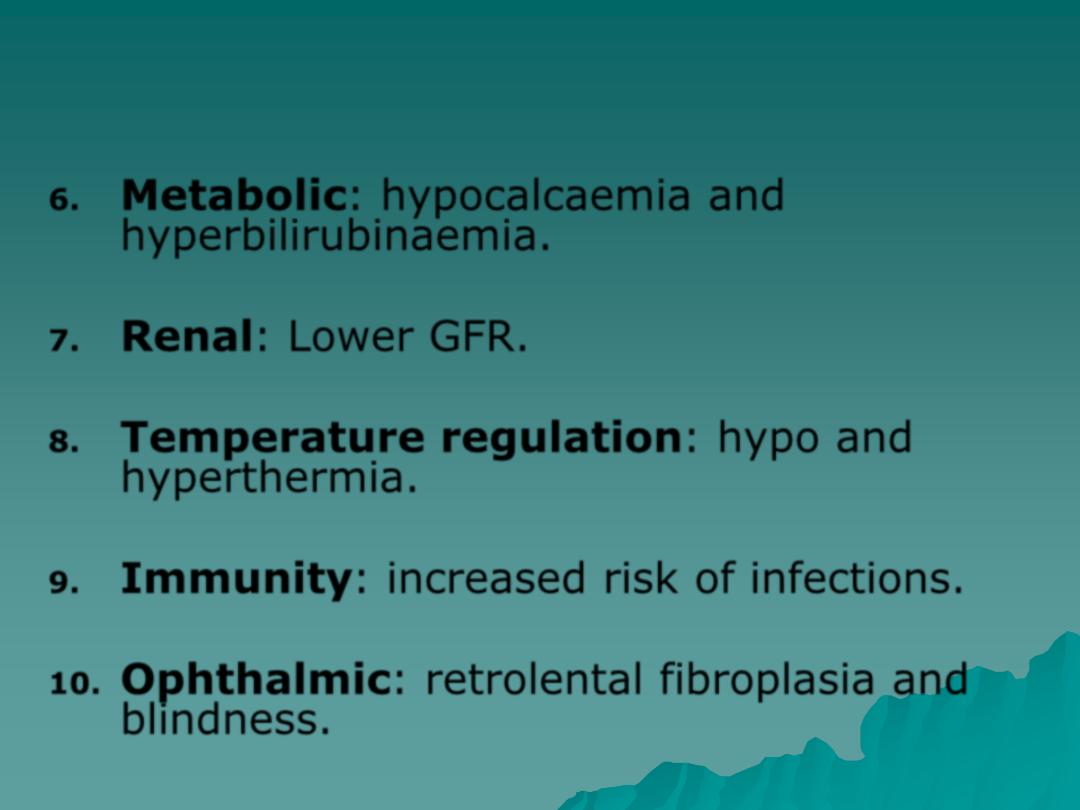
Causes of Morbidity and Mortality;
Immediate:
6.
Metabolic: hypocalcaemia and
hyperbilirubinaemia.
7.
Renal: Lower GFR.
8.
Temperature regulation: hypo and
hyperthermia.
9.
Immunity: increased risk of infections.
10.
Ophthalmic: retrolental fibroplasia and
blindness.
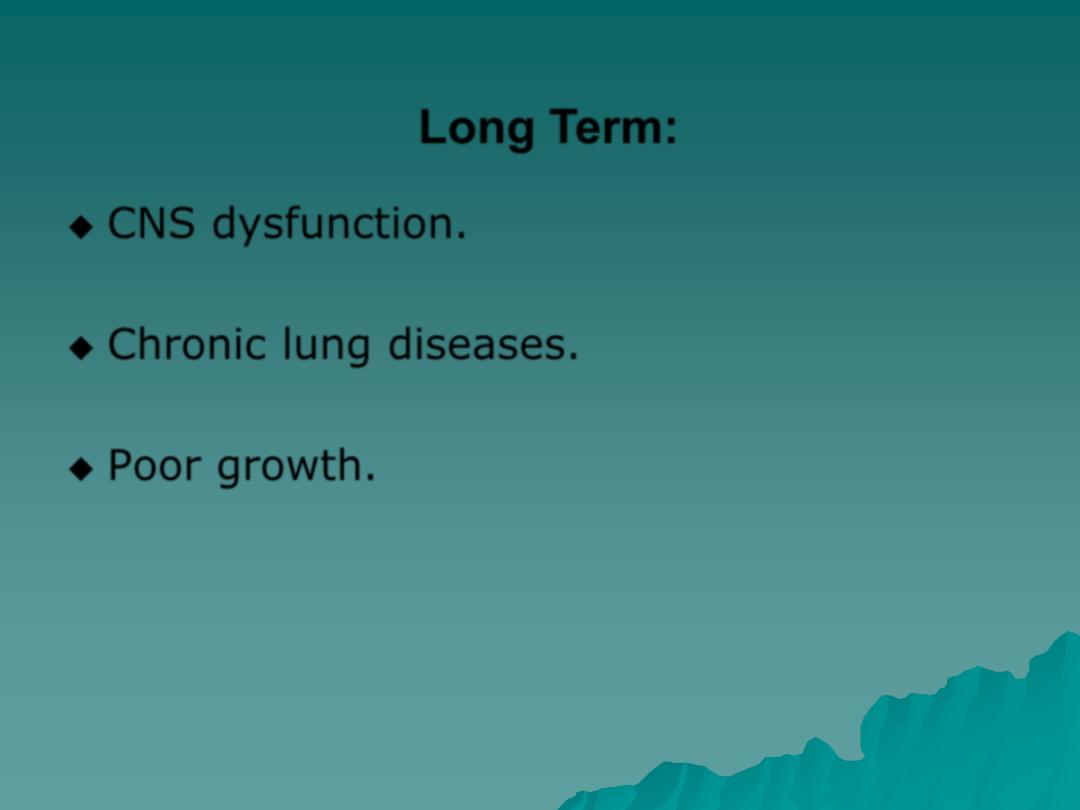
CNS dysfunction.
Chronic lung diseases.
Poor growth.
In Iraq LBW decreased from up to 22%
during the nineties to 10.2%, 6.06%
& 5.9% during 2010, 2011 & 2012
respectively
Causes of Morbidity and Mortality;
Long Term:
